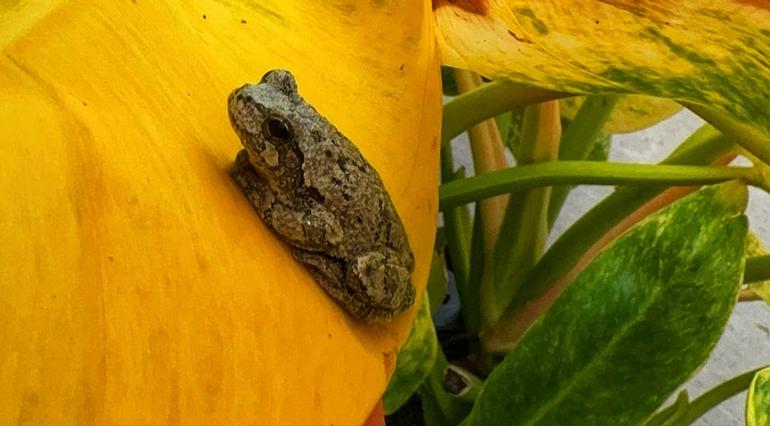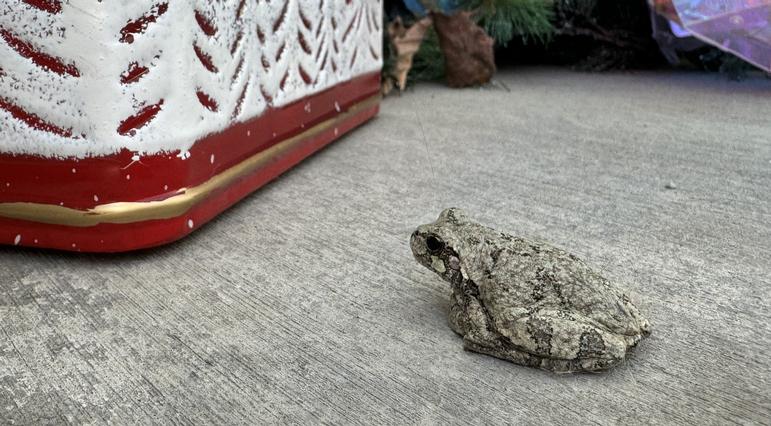Tiny Frog, Big Role

This spring the wet weather brought an abundance of little green treefrogs hopping around and they hung out most of the summer. Hence, we weren't too surprised when one found its way into the greenhouse among the houseplants! These small, fascinating visitors are true friends of our garden, and they never fail to capture our curiosity. Want to know more about these delightful little frogs? Read on to discover why Cope's gray treefrog is such a remarkable part of our ecosystem!
If you've ever heard a high-pitched trill echoing from the trees on a warm spring or summer night, you might have been listening to Cope’s gray treefrog (Hyla chrysoscelis). This tiny, camouflaged marvel is easy to miss despite its unique features and fascinating abilities. Native to North America, particularly the eastern United States, Cope’s gray treefrog thrives in woodlands, wetlands, and even suburban gardens, offering benefits as both a natural pest controller and an indicator of ecosystem health.
Let’s dive into what makes this treefrog special and why its presence in your backyard is worth celebrating!
1. Tiny, Adaptable, and Almost Invisible
At only about 1.25 to 2 inches long, Cope’s gray treefrog might be small, but it has an impressive camouflage. Its skin color can change from gray to green, helping it blend seamlessly with tree bark, leaves, and surrounding foliage. This ability to shift color based on its environment and mood is what often makes it challenging to spot. However, during the breeding season, a surprise awaits under their legs: bright yellow-orange thigh patches that only show when the frog is in motion. This splash of color serves as a warning to predators, adding an extra layer of defense to its otherwise subdued appearance.
2. The Science of the Trill
One of the key ways to identify Cope’s gray treefrog is by its call. Males produce a high-pitched, rapid trill during the breeding season, usually from spring to early summer, as they seek to attract females. The trill is distinct and can be heard from far away, especially near ponds, marshes, and other water sources. This call is the main feature that distinguishes Cope’s gray treefrog from its close relative, the eastern gray treefrog (Hyla versicolor), which has a slower and lower-pitched trill.
3. A True Survivor: Cold Adaptations
One of Cope’s gray treefrog’s most remarkable traits is its ability to withstand cold temperatures. As winter approaches, these frogs produce a natural "antifreeze" in the form of glycerol, which prevents their body tissues from freezing. This feature allows them to survive even when their surroundings drop well below freezing. When temperatures warm up, they emerge from hibernation as healthy as ever, ready for the next season.
4. Diet: A Pest Control Powerhouse
These little frogs may be small, but they have big appetites! Cope’s gray treefrogs feed on various small insects, spiders, and other invertebrates, often hunting in the trees and shrubs where they live. Their sticky toe pads give them incredible climbing skills, allowing them to cling to vertical surfaces while they hunt. This diet makes them fantastic natural pest controllers, helping to keep bug populations in check in your garden or local forest.
5. A Sign of a Healthy Environment
Because Cope’s gray treefrog is sensitive to changes in its environment, its presence indicates a healthy ecosystem. Frogs are often known as “bioindicators,” meaning that a thriving frog population suggests clean water, fresh air, and minimal pollutants in the environment. Conversely, a decline in frog populations can signal issues within the ecosystem. If you’re lucky enough to see or hear these frogs, it’s likely that local habitats are in good shape.
Caring for Your Local Treefrog Population
If you want to encourage Cope’s gray treefrogs in your area, consider making your garden frog-friendly:
- Provide Water Sources: Frogs need water for breeding and hydration. Adding a small pond or water feature to your garden can help attract them.
- Avoid Pesticides: Since frogs are sensitive to chemicals, minimizing pesticide use is essential to keep them safe.
- Plant Native Vegetation: Native plants can create a welcoming environment for treefrogs and the insects they feed on.
- Add Leaf Litter and Rocks: Frogs love hiding spots, so leaving leaf litter, logs, or rocks around your garden will give them places to shelter and hunt.
Cope’s gray treefrog may be small and well-camouflaged, but its presence brings life, music, and benefits to the garden. From its trilling calls to its natural pest control abilities, this little frog is a true garden ally and a delightful reminder of nature’s diversity. If you hear the call of Cope’s gray treefrog one evening, take a moment to appreciate the hidden wildlife right in your own backyard. It’s a small sound with a big message: the ecosystem around you is alive and well!
By celebrating and caring for these tiny amphibians, we support biodiversity and maintain the natural balance in our outdoor spaces.
